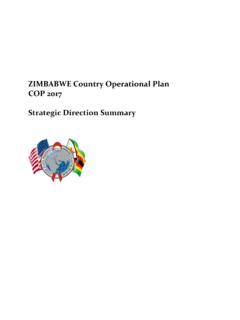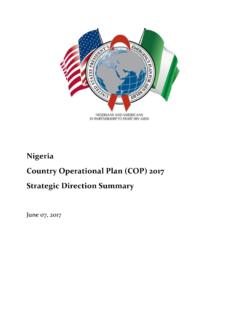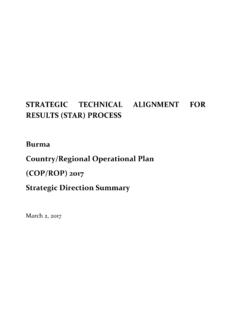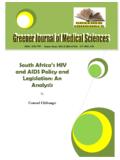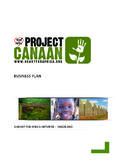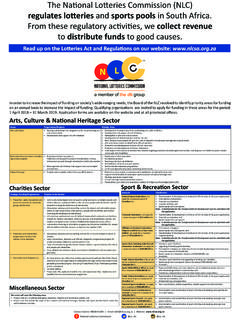Transcription of South Africa Country Operational Plan 2016 …
1 South Africa Country Operational plan 2016 (COP16) Strategic Direction Summary (SDS) Implementation - October 2016 - September 2017 Submitted 14 April 2016 ; approved 19 May 2016 Ver. 8 June 2016 S A C O P 1 6 S D S A p p r o v e d 1 9 M a y 2 0 1 6 2 | P a g e Table of Contents Goal Statement Epidemic, Response, and Program Context Summary statistics, disease burden and epidemic profile Investment profile Sustainability Profile Alignment of PEPFAR investments geographically to burden of disease Stakeholder engagement Core, near-core and non-core activities for operating cycle Geographic and population prioritization Program Activities for Epidemic Control in Scale-up Locations and Populations Targets for scale-up locations and populations Priority population prevention Voluntary medical male circumcision (VMMC)
2 Preventing mother-to-child transmission (PMTCT) HIV testing and counseling (HTS) Facility and community-based care and support TB/HIV Adult treatment Pediatric Treatment OVC Program Activities in Sustained Support Locations and Populations Package of services and expected volume in sustained support locations and populations Program Support Necessary to Achieve Sustained Epidemic Control Critical systems investments for achieving key programmatic gaps Critical systems investments for achieving priority policies Proposed system investments outside of programmatic gaps and priority policies USG Management, Operations and Staffing plan to Achieve Stated Goals Appendix A- Core, Near-core.
3 Non-core Matrix Appendix B- Budget Profile and Resource Projections Appendix C- Systems Investments for Section S A C O P 1 6 S D S A p p r o v e d 1 9 M a y 2 0 1 6 3 | P a g e Goal Statement In support of the South Africa National Strategic plan (NSP) for HIV and AIDS, TB and STIs (NSP), the United States through PEPFAR will implement a broad portfolio of programs toward the goal of epidemic control in the 27 highest HIV burden focus districts in South Africa , representing 82 percent of PLHIV. The strategy for the PEPFAR Country Operational plan for the period from October 1, 2016 through September 30, 2017 (COP16) will continue program strategic priorities identified and implemented in COP15. The overall goals align PEPFAR with South African government, Global Fund and other resources to support the Joint United Nations Program on HIV/AIDS (UNAIDS) 90-90-90 targets (90 percent of all people living with HIV know their status, 90 percent of all people diagnosed with HIV infection receive Antiretroviral Therapy (ART), 90 percent of all people receiving ART have viral suppression), and improve linkages and program planning between prevention, treatment and orphans and vulnerable children (OVC) programs at the community and facility levels.
4 PEPFAR s support to the national HIV program is coordinated under the South African and governments Partnership Framework Implementation plan (PFIP), which establishes joint work streams to support alignment of PEPFAR s contributions to the NSP. In COP16 PEPFAR is using the South Africa National Development plan , the NSP, epidemiologic and expenditure data, and South Africa s Investment Case, to plan and strategically focus on achieving 90-90-90 in five of the 27 focus districts by September 2017. PEPFAR s support for health systems strengthening initiatives will support sustainability and contribute to South Africa s goals to improve health care in the public health system in anticipation of National Health Insurance.
5 On May 10, 2016 South African Minister of Health Motsoaledi announced that South Africa will implement an evidence-based policy of offering ART to all people living with HIV beginning in September 2016 . National adoption of WHO guidelines recommending Test and Treat (ending CD4 eligibility criteria initiating ART) will begin in September 2016 . PEPFAR will support the national rollout by initiating test and treat in four of the 27 focus districts in COP15, then in all 27 focus districts in COP16, along with innovations to transition/decant stable ART clients to alternative modes of service and ARV delivery, in order to decongest public health facilities. In COP16 PEPFAR will focus key prevention interventions, including alignment with five DREAMS1 priority districts and the expanded coverage of voluntary male medical circumcision (VMMC) services in all 27 focus districts.
6 COP16 programs include increased effectiveness of HIV testing, enhancing men s access to services, improved health information management systems, electronic medical records and use of data for strategic planning. PEPFAR will continue with the South Africa government to make the best use of evidence in monitoring and evaluating the program, and align the PEPFAR POART2 process of quarterly reviews with the South African-led District HIV/TB Implementation Plans (DIP) process. 1 DREAMS: Determined, Resilient, Empowered, AIDS-free, Mentored and Safe adolescent girls and young women (AGYW) 2 PEPFAR Oversight and Accountability Results Team (POART) process reviews performance quarterly.
7 S A C O P 1 6 S D S A p p r o v e d 1 9 M a y 2 0 1 6 4 | P a g e In COP16 PEPFAR specific inputs will focus on: Technical Assistance (TA) and in some circumstances direct service delivery (DSD) for care and treatment services to identify and support million South Africans on ART in the 27 focus districts by September 2017 Increasing yield and effectiveness of HIV testing in communities and facilities, and strengthening linkage to care Improving clinical facility and community linkages, and enhancing the decanting of 650,000 stable ART patients Improving treatment adherence, retention and viral load suppression Combination prevention, including prevention of mother-to-child transmission (PMTCT)
8 , condoms, VMMC, ART, services tailored to reach key and other vulnerable populations ( , young women and girls, men who have sex with men (MSM), and female sex workers (FSW)), and other comprehensive prevention programs Holistic OVC programs linked to ART and prevention interventions National and provincial level systems strengthening and strategic program areas for information systems, human resources, laboratory, and improved service delivery and supply chain. Epidemic, Response, and Program Context Summary statistics, disease burden, and Country profilei South Africa s HIV epidemic is largely driven by heterosexual transmission, with underlying behavioral, socio-cultural, economic, and structural factors that influence HIV transmission risk.
9 These factors include population mobility and migration, race, economic, and educational status; alcohol and drug use; early sexual debut; sexual violence; low prevalence of male circumcision; lack of knowledge of HIV status; intergenerational sex; multiple and concurrent sexual partners; discrimination and stigmatization; and inconsistent condom use, especially in longer-term relationships and during pregnancy/post-partum. In particular, gender dynamics and unequal power relations between men and women play a significant role in heterosexual HIV transmission. Approximately 54 percent of HIV-infected adults are women, black women aged 25-34 years having the highest prevalence, at percent, and highest incidence, at 1.
10 Total population: million, approximately 51 percent ( million) are females. Life expectancy at birth for 2015 was estimated at years for males and years for females, while infant mortality rate was per 1,000 live births4. 3 Human Sciences Resource Council (HSRC) Household survey, 2012 4 Statistics South Africa (StatsSA) Mid-year population estimates 2015. Statistical Release P0302, Statistics South Africa : Pretoria. S A C O P 1 6 S D S A p p r o v e d 1 9 M a y 2 0 1 6 5 | P a g e 2. HIV disease burden: UNAIDS estimates (2014), 6,800,000 [6,500,000 - 7,500,000] people were living with HIV with [ - ] percent of adults (15-49 years) HIV-positive.
